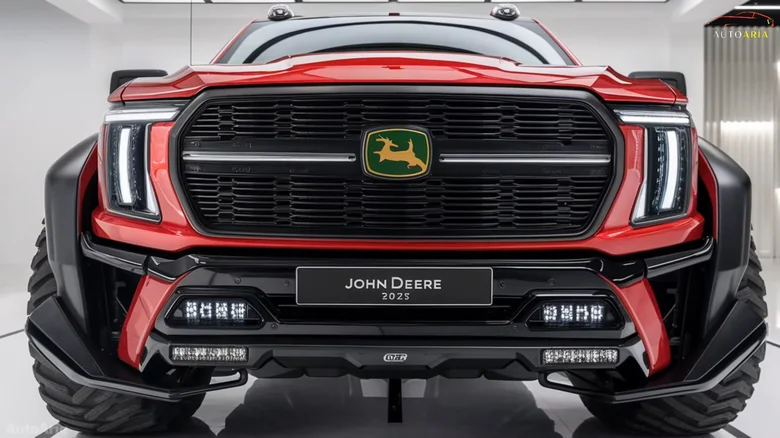John Deere is a name synonymous with agriculture, lawn care, and heavy machinery. From its iconic green and yellow tractors to its high-tech farming equipment, the brand has built a legacy of reliability and innovation. But recently, rumors have been swirling that John Deere is venturing into uncharted territory: the pickup truck market. Images of a rugged, muscular John Deere pickup truck have gone viral, sparking excitement and speculation. However, before you start saving up for a John Deere truck, let’s separate fact from fiction and dive into why this rumor is likely false.
The Origin of the Rumor
The rumor of a John Deere pickup truck gained traction online, with AI-generated images fueling the buzz. These images depict a variety of designs, from a squat, off-road-ready beast with oversized tires to a more conventional pickup in classic John Deere colors. The idea of a John Deere truck seems appealing, especially to fans of the brand who appreciate its rugged, no-nonsense aesthetic.
However, despite the excitement, there’s one glaring issue: John Deere has made no official announcement about entering the automotive market. The company has not confirmed any plans to produce a pickup truck, nor has it hinted at such a move. So, where did these images come from, and why are they so convincing?
The Role of AI in Spreading Misinformation

The images circulating online are not real concept designs or leaked prototypes—they’re the work of artificial intelligence. AI tools have become increasingly sophisticated, allowing users to create hyper-realistic images of vehicles that don’t exist. These tools are often used to generate engagement on social media, where eye-catching visuals can quickly go viral.
Unfortunately, this practice has led to widespread misinformation. In the case of the John Deere pickup truck, AI-generated images have been shared as if they were real, misleading enthusiasts and sparking false hope. This trend is particularly prevalent in the automotive world, where fans are always eager for news about the latest models and innovations.
How to Spot AI-Generated Car Images
While AI-generated images can be incredibly convincing, there are often telltale signs that give them away. Here’s how you can identify fake car images:
- Inconsistent Logos and Branding: AI tools sometimes struggle to replicate logos accurately. Look for subtle errors in the John Deere logo or other branding elements.
- Mismatched Text: AI-generated images may feature garbled or nonsensical text on license plates, badges, or decals.
- Repetition and Patterns: AI can struggle with repeating patterns, such as grille designs or tire treads. Look for irregularities or inconsistencies in these areas.
- Lack of Official Sources: If a major automaker like John Deere were entering the pickup truck market, it would likely make an official announcement. The absence of credible sources is a red flag.
Why John Deere Is Unlikely to Enter the Pickup Truck Market

John Deere’s core business revolves around agriculture, construction, and lawn care equipment. While the company has diversified its offerings over the years—such as venturing into snowmobiles and drivetrain components—it has shown no interest in producing street-legal vehicles.
Here are a few reasons why a John Deere pickup truck is unlikely:
- Brand Identity: John Deere is deeply rooted in the farming and construction industries. Entering the highly competitive pickup truck market would be a significant departure from its core expertise.
- Market Competition: The pickup truck market is dominated by established players like Ford, Chevrolet, and Ram. Breaking into this space would require substantial investment and innovation.
- No Official Announcement: John Deere has not made any statements or released any official documents about developing a pickup truck. Without confirmation from the company, the rumor remains unfounded.
Debunking the Specs and Designs
Even if we set aside the lack of official confirmation, the alleged John Deere pickup truck designs and specifications don’t hold up under scrutiny. Here’s why:
- Inconsistent Designs: The AI-generated images vary widely in terms of design, from headlight shapes to grille patterns. This inconsistency suggests a lack of a unified vision.
- Vague Specifications: Some sources claim the truck would feature a 3.5-liter, 4.5-liter, or 5.0-liter V8 engine, while others omit engine details entirely. This lack of consistency is a red flag.
- Unrealistic Trim Names: The rumored trim levels—Cultivator, Harvester, and Titan—sound more like marketing gimmicks than genuine product names.
What’s Next for John Deere?

While the idea of a John Deere pickup truck is exciting, it’s important to focus on what the company is actually doing. John Deere continues to innovate in its core markets, developing advanced farming equipment, autonomous tractors, and sustainable solutions for modern agriculture.
For now, John Deere is staying true to its roots, focusing on the products and industries that have made it a household name. And while we may not see a John Deere pickup truck anytime soon, the brand’s commitment to innovation ensures that it will remain a leader in its field.
Final Thoughts
The rumor of a John Deere pickup truck is a fascinating example of how AI-generated content can blur the lines between fact and fiction. While the idea of a rugged, John Deere-branded truck is undeniably appealing, there’s no evidence to support the claim.
As consumers, it’s important to approach viral rumors with a critical eye and rely on credible sources for information. In the meantime, let’s celebrate John Deere for what it does best: building the machines that help feed, build, and maintain our world.








